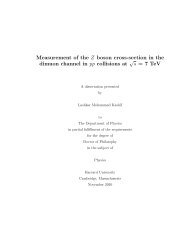2 The CDF Experiment at Fermilab Contents - Harvard University ...
2 The CDF Experiment at Fermilab Contents - Harvard University ...
2 The CDF Experiment at Fermilab Contents - Harvard University ...
You also want an ePaper? Increase the reach of your titles
YUMPU automatically turns print PDFs into web optimized ePapers that Google loves.
54 Section 2: <strong>CDF</strong> Physics Analysis<br />
2.3.3 <strong>The</strong> W Mass Measurement<br />
(Prof. Franklin & Dr. Gordon)<br />
<strong>The</strong> W mass is measured <strong>at</strong> <strong>CDF</strong> using both electron and muon decay channels. <strong>The</strong><br />
<strong>Harvard</strong> group worked on the electron decay mode. W ! e decays are characterized by<br />
a high E T electromagnetic cluster and large 6E T , where the EM cluster has a high P T track<br />
pointing <strong>at</strong> it. Here E T refers to the calorimeter measurement and P T to the measurement<br />
from the central tracking chamber (CTC). <strong>The</strong> W mass is extracted from a t to the transverse<br />
mass distribution. Using the d<strong>at</strong>a (80 pb ,1 ) from Run IB, a st<strong>at</strong>istical error of 70 MeV<br />
is obtained, which is half the error of the previous measurement.<br />
An equally large source of uncertainty arises from the determin<strong>at</strong>ion of calorimeter energy<br />
scale. Z decays can be used to set the energy scale with an uncertainty of 0:1%. We can<br />
also tie the calorimeter scale to the CTC scale with the peak of the E/p distribution, where E<br />
is the calorimeter measurement, and p is the CTC measurement of the electron. Attothe<br />
E/p distribution is shown in Figure 28. Bremsstrahlung causes a shift in the peak and also<br />
cre<strong>at</strong>es a large high-end tail. <strong>The</strong> st<strong>at</strong>istical error associ<strong>at</strong>ed on the peak position is 0:04%,<br />
and there is an additional uncertainty from the amount of m<strong>at</strong>erial inducing Bremsstrahlung<br />
of 0:04%. <strong>The</strong> corresponding error on M W is also 0:04%.<br />
Unfortun<strong>at</strong>ely, the energy scale as determined from the E/p distribution and from the<br />
Z mass dier by 0:45%, and this is a 4 devi<strong>at</strong>ion. Simply st<strong>at</strong>ed, if we set the energy<br />
scale using the E/p distribution, then we measure avalue for the Z mass which is 410 MeV<br />
too low. A gre<strong>at</strong> deal of eort has been expended looking for the solution to this problem.<br />
Among other things, we have checked the following:<br />
<strong>The</strong> E/p distribution from Z decays agrees with the distribution from W decays, which<br />
indic<strong>at</strong>es th<strong>at</strong> the problem is not a simple non-linearity in the energy scale between<br />
W and Z energy scales.<br />
Possible non-linearities were further constrained by obtaining the E/p distribution<br />
from decays ! e + e , . Extreme non-linearities would be required to explain the E/p<br />
anomaly, and are completely ruled out from this distribution.<br />
We have applied our Monte Carlo to analyze the Run Ia d<strong>at</strong>a and have reproduced the<br />
Run Ia results well, including both the Z mass and E/p distribution. This indic<strong>at</strong>es<br />
th<strong>at</strong> we have not introduced a bug by various changes in the simul<strong>at</strong>ion. Wh<strong>at</strong>ever















